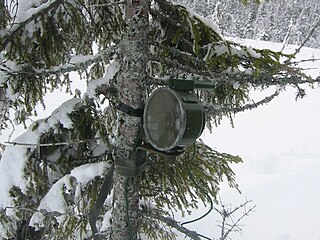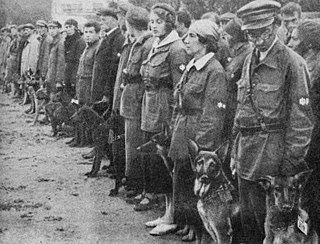Related Research Articles

A land mine is an explosive device concealed under or on the ground and designed to destroy or disable enemy targets, ranging from combatants to vehicles and tanks, as they pass over or near it. Such a device is typically detonated automatically by way of pressure when a target steps on it or drives over it, although other detonation mechanisms are also sometimes used. A land mine may cause damage by direct blast effect, by fragments that are thrown by the blast, or by both.

The M18A1 Claymore is a directional anti-personnel mine developed for the United States Armed Forces. Its inventor, Norman MacLeod, named the mine after a large medieval Scottish sword. Unlike a conventional land mine, the Claymore is command-detonated and directional, meaning it is fired by remote-control and shoots a pattern of metal balls into the kill zone like a shotgun. The Claymore can also be victim-activated by booby-trapping it with a tripwire firing system for use in area denial operations.
The GATOR mine system is a United States military system of air-dropped anti-tank and anti-personnel mines developed in the 1980s to be compatible with existing cluster dispensers. It is used with two dispenser systems—the Navy 230 kg (500 lb) CBU-78/B and the Air Force 450 kg (1,000 lb) CBU-89/B. Additionally the mines are used with the land- and helicopter-based Volcano mine system.

The Carl Gustaf recoilless rifle is an 84-mm man-portable reusable anti-tank weapon produced by Saab Bofors Dynamics in Sweden. Introduced in 1946, it was one of the many recoilless rifle designs of that era. While similar weapons have generally disappeared from service, the Carl Gustaf is still being made and remains in widespread use today. The Carl Gustaf is a lightweight, low-cost weapon that uses a wide range of ammunition, which makes it extremely flexible and suitable for a wide variety of roles.

Bofors Carl Gustaf AB is a Swedish armaments firm, now owned by Bofors.
Pansarsprängvinggranat m/94STRIX is a Swedish endphase-guided projectile fired from a 120 mm mortar currently manufactured by Saab Bofors Dynamics.

An anti-tank mine is a type of land mine designed to damage or destroy vehicles including tanks and armored fighting vehicles.

E85 is an abbreviation typically referring to an ethanol fuel blend of 85% ethanol fuel and 15% gasoline or other hydrocarbon by volume.

A flexible-fuel vehicle (FFV) or dual-fuel vehicle is an alternative fuel vehicle with an internal combustion engine designed to run on more than one fuel, usually gasoline blended with either ethanol or methanol fuel, and both fuels are stored in the same common tank. Modern flex-fuel engines are capable of burning any proportion of the resulting blend in the combustion chamber as fuel injection and spark timing are adjusted automatically according to the actual blend detected by a fuel composition sensor. Flex-fuel vehicles are distinguished from bi-fuel vehicles, where two fuels are stored in separate tanks and the engine runs on one fuel at a time, for example, compressed natural gas (CNG), liquefied petroleum gas (LPG), or hydrogen.
National Defence Complex (NDC), also known as National Development Complex, National Development Centre, is a Pakistani state-owned defence and aerospace contractor which is a division under the National Engineering and Scientific Commission (NESCOM). It is based in Fateh Jang, Rawalpindi, Pakistan.

The FFV 016 is a Swedish designed off-route mine designed for use against lightly armoured vehicles. The mine uses a Misznay Schardin effect warhead to produce a self-forging fragment that has an initial velocity of approximately 2,000 metres per second and can penetrate 60 mm of armour at 30 metres range. The mine's body is circular, with a dished front which is aimed using a simple built in sight along the expected route of the target.
FFV1, which stands for "FF video codec 1", is a lossless intra-frame video codec. It can use either variable length coding or arithmetic coding for entropy coding. The encoder and decoder are part of the free, open-source library libavcodec in the project FFmpeg since June 2003. FFV1 is also included in ffdshow and LAV Filters, which makes the video codec available to Microsoft Windows applications that support system-wide codecs over Video for Windows (VfW) or DirectShow. FFV1 is particularly popular for its performance regarding speed and size, compared to other lossless preservation codecs, such as M-JPEG2000. The European Broadcasting Union (EBU) lists FFV1 under the codec-family index "31" in their combined list of video codec references.

The FFV 028 is a series of steel cased Swedish anti-tank mines that use electronic fuzes. The mines are circular, with a large Misznay Schardin effect warhead in the center of the mine, with the fuzing and sensor electronics located in the dead space above the main charge. The design of the mine dates from the 1970s and uses a magnetic influence sensor to detonate the mine, making it able to attack the full width of armoured vehicles.
The M141 Bunker Defeat Munition (BDM), or SMAW-D ("Disposable"), is a single-shot, shoulder-launched weapon designed to defeat hardened structures. The weapon was designed as a modification of the United States Marine Corps Shoulder-launched Multipurpose Assault Weapon (SMAW) to fill the void in the United States Army inventory of a "bunker buster" weapon.

Anti-tank dogs were dogs taught to carry explosives to tanks, armored vehicles and other military targets. They were intensively trained by the Soviet and Russian military forces between 1930 and 1996, and used in 1941–1942, against German tanks in World War II. Although the original dog training routine was to leave the bomb, and retreat, so that the bomb would be detonated by the timer, this routine failed, and was replaced by an impact-detonation-procedure which killed the dog in the process. The U.S. military trained anti-tank dogs in 1943, for use against fortifications, but never deployed them.

The Miniman is a disposable single-shot 74-mm unguided anti-tank smooth bore recoilless weapon, designed in Sweden by Försvarets Fabriksverk (FFV) and became operational in 1968. The Miniman is delivered with the HEAT projectile pre-loaded launch tube. In appearance, the Miniman is similar to a single section tube US M72 LAW and French SARPAC of the same era. In 1986 the Swedish Army adopted the FFV AT4, designated the Pansarskott m/86, to replace the Miniman. FFV engineers adopted the rugged but simple firing and safety mechanism of the Miniman for the AT4. The Miniman uses a unique version of the high-low chamber launch system that results in no recoil.
Beyond-armour effect is a term coined by Försvarets Fabriksverk (FFV), a semi-governmental Swedish defense firm, while developing the AT4. From the 1980s this phrase was used in its brochures, press releases, weapon instruction manuals and other documentation to denote the post-penetration effect of the AT4's HEAT anti-armour warhead against the interior and occupants of armoured vehicles.
The AT4 is an 84-mm unguided, portable, single-shot recoilless smoothbore weapon built in Sweden by Saab Bofors Dynamics. Saab has had considerable sales success with the AT4, making it one of the most common light anti-tank weapons in the world.

The FFV 890 was a Swedish assault rifle manufactured and designed by Försvarets Fabriksverk. The FFV 890 was based on the Israeli IMI Galil through a manufacturing licence, which in turn was based on the Finnish Valmet RK 62 and ultimately the Soviet AK-47. The FFV 890 was designed between 1975 and 1980, and its final iteration, FFV 890C, competed in the Swedish Armed Forces trials for the new 5.56×45mm NATO assault rifle, where it ended up as a runner-up to the FN FNC, which was then chosen as the Ak 5. The FFV 890C was never widely adopted by any service, though some rifles were used by the Swedish police.